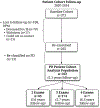The association between lifestyle factors and Parkinson's disease progression and mortality
- PMID: 30653734
- PMCID: PMC6544143
- DOI: 10.1002/mds.27577
The association between lifestyle factors and Parkinson's disease progression and mortality
Abstract
Background: Lifestyle factors may contribute to the development of Parkinson's disease, but little is known about factors that influence progression. The objective of the current study was to examine whether caffeine or alcohol consumption, physical activity, or cigarette smoking is associated with progression and survival among PD patients.
Methods: We assessed lifelong coffee, tea, and alcohol consumption, smoking, and physical activity in a prospective community-based cohort (n = 360). All patients were passively followed for mortality (2001-2016); 244 were actively followed on average ± SD 5.3 ± 2.1 years (2007-2014). Movement disorder specialists repeatedly assessed motor function (Hoehn & Yahr) and cognition (Mini-Mental State Exam). We used Cox proportional hazards models and inverse probability weights to account for censoring.
Results: Coffee, caffeinated tea, moderate alcohol consumption, and physical activity were protective against at least 1 outcome. Smoking and heavy alcohol consumption were associated with increased risks. Coffee was protective against time to Hoehn & Yahr stage 3 (hazard ratio, 0.52; 95% confidence interval, 0.28-1.01), cognitive decline (hazard ratio, 0.23; 95% confidence interval, 0.11, 0.48), and mortality (hazard ratio, 0.47; 95% confidence interval, 0.32-0.69). Relative to moderate drinkers, those who never drank liquor and those who drank more heavily were at an increased risk of Hoehn & Yahr 3 (hazard ratio, 3.48; 95% confidence interval, 1.90-6.38; and hazard ratio, 2.16; 95% confidence interval, 1.03, 4.54, respectively). A history of competitive sports was protective against cognitive decline (hazard ratio, 0.46; 95% confidence interval, 0.22-0.96) and Hoehn & Yahr 3 (hazard ratio, 0.42; 95% confidence interval, 0.23-0.79), as was physical activity measured by metabolic-equivalent hours. Current cigarette smoking was associated with faster cognitive decline (hazard ratio, 3.20; 95% confidence interval, 1.02-10.01).
Conclusions: This population-based study suggests that lifestyle factors influence PD progression and mortality. © 2019 International Parkinson and Movement Disorder Society.
Keywords: Parkinson's disease; alcohol; coffee; cognition; progression.
© 2019 International Parkinson and Movement Disorder Society.
Conflict of interest statement
Figures
References
-
- Pfeiffer RF. Non-motor symptoms in Parkinson’s disease. Park Relat Disord 2016;22:S119–S122. - PubMed
-
- Hernán MA, Takkouche B, Caamaño-Isorna F, Gestal-Otero JJ. A meta-analysis of coffee drinking, cigarette smoking, and the risk of Parkinson’s disease. Ann Neurol 2002;52(3):276–284. - PubMed
-
- Ascherio A, Schwarzschild MA. The epidemiology of Parkinson’s disease: risk factors and prevention. Lancet Neurol 2016;15(12): 1257–1272. - PubMed
-
- Alves G, Kurz M, Lie SA, Larsen JP. Cigarette smoking in Parkinson’s disease: influence on disease progression. Mov Disord 2004; 19(9):1087–1092. - PubMed
Publication types
MeSH terms
Substances
Grants and funding
- Veterans Administration Healthcare System (SW PADRECC)/International
- Levine Foundation/International
- U54 ES012078/ES/NIEHS NIH HHS/United States
- Parkinson Alliance/International
- U54-ES012078/National Institute of Environmental Health Science/International
- R01 ES010544/ES/NIEHS NIH HHS/United States
- American Parkinson's Disease Association (APDA)/International
- F32-ES028087/National Institute of Environmental Health Science/International
- L30 ES029738/ES/NIEHS NIH HHS/United States
- R01-ES010544/National Institute of Environmental Health Science/International
- F32 ES028087/ES/NIEHS NIH HHS/United States


